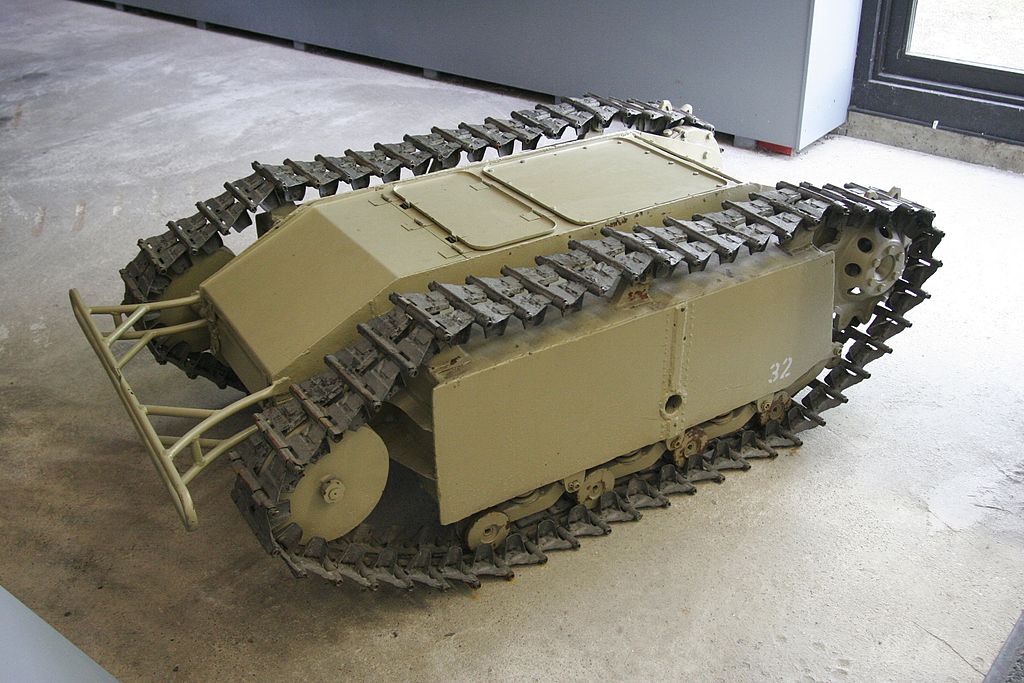
Among the most numerous of the German anti-mine vehicles was the Leichte Ladungsträger Goliath SdKfz 302. This was a small wire-guided vehicle designed for minefield clearance, destruction of enemy installations or in extreme cases, as an antitank weapon. The Goliath measured only about 1.5 meters, and the initial version was considered too small and underpowered. This version was known as SdKfz 302a (E-Motor) and was powered by two Bosch MM/RQL 2500/24 RL2 electric motors. Borgward and Zündapp produced 2,650 units of this type from April 1942 to January 1944.
The second version of the Goliath was known as the SdKfz 302b (V-Motor). This was powered by a Zündapp SZ7 two-cylinder, two-stroke engine and was larger and could carry more explosives. The manufacturers Zündapp and Zachertz built 325 units by November 1944. Regardless of the type, a control-wire drum was located at the rear of the vehicle that contained a three-strand wire, two strands for driving the vehicle and a third for detonating the charge. For transport the Goliath could be mounted and towed on a two-wheeled trailer.
The interior of a Goliath, SdKfz. 303, showing the petrol engine, control cable reels and the space for the warhead. U.S. Department of Ordnance – Catalog of Enemy Ordnance Manual Vol. 1 – 1945
“Goliath” leichte Ladungsträger (SdKfz 302 & 303)
Developed by Borgward, the three versions of this vehicle were among the most interesting German engineered vehicles, at least in the eyes of the average GI or Tommy encountering them.
These tethered remote-controlled demolition vehicles were about five feet long and weighed less than a half ton. Consistent with the tongue-in-cheek naming of certain German vehicles (the 200-ton superheavy tank was named “mouse”), this vehicle’s name was Goliath.
Development of the vehicle began in 1940 when Borgward was ordered to create a very small electrically powered vehicle capable of placing a charge of about 50 kgs.
The design that was approved was powered by two electric motors and carried a 60 kg charge. Control of the vehicle was via a wire which unwound out of the rear compartment of the vehicle as it advanced.
Despite being protected by a 6 mm armor plate at the front, in practice the vehicles were easily defeated either by small-arms fire through the unarmored sides, or by merely severing the control cable.
Production of this vehicle, which was given the Sonderkraftfahrzeug (special purpose vehicle—SdKfz) number 302, began in April 1942. The considerable expense of the vehicles, along with the limitations, in particular the vulnerability of the electric drive, led to production being discontinued in January 1944, after 2,635 had been completed.
This was not the end of Goliath, however. In April 1943 a much improved, slightly larger version entered production.
Assigned SdKfz number 303, other than a slight increase in size, the most dramatic change was the use of a two-stroke Zundapp gasoline engine to power the diminutive tracklaying vehicle. The frontal armor was upgraded to 10 mm, and strangely the gasoline-powered variant seemed more tolerant of small-arms fire than was the electric model, but nevertheless some of the handicaps remained. Among these, the vulnerability of the sides, and the reliance on the rear spooling wire leading to the tethered remote control.
A total of 4,929 gasoline-powered versions of the SdKfz 303 were produced in two models, the SdKfz 303b having a slightly larger payload charge of 100 kgs, compared to 75 kgs for the SdKfz 303a.
The Goliath began to be issued in January 1942, and was first used near Sevastopol in June. Additional units were created and equipped with 162 Goliath each beginning in October 1942. By 1944 the SdKfz 303 was being issued thirty-each to normal Pioneer (Engineer) battalions.